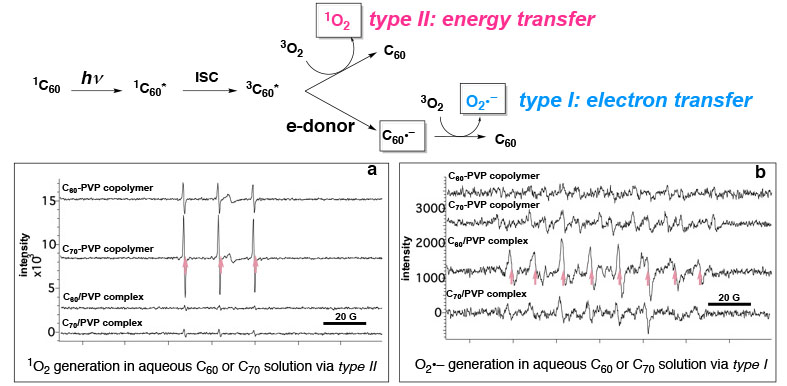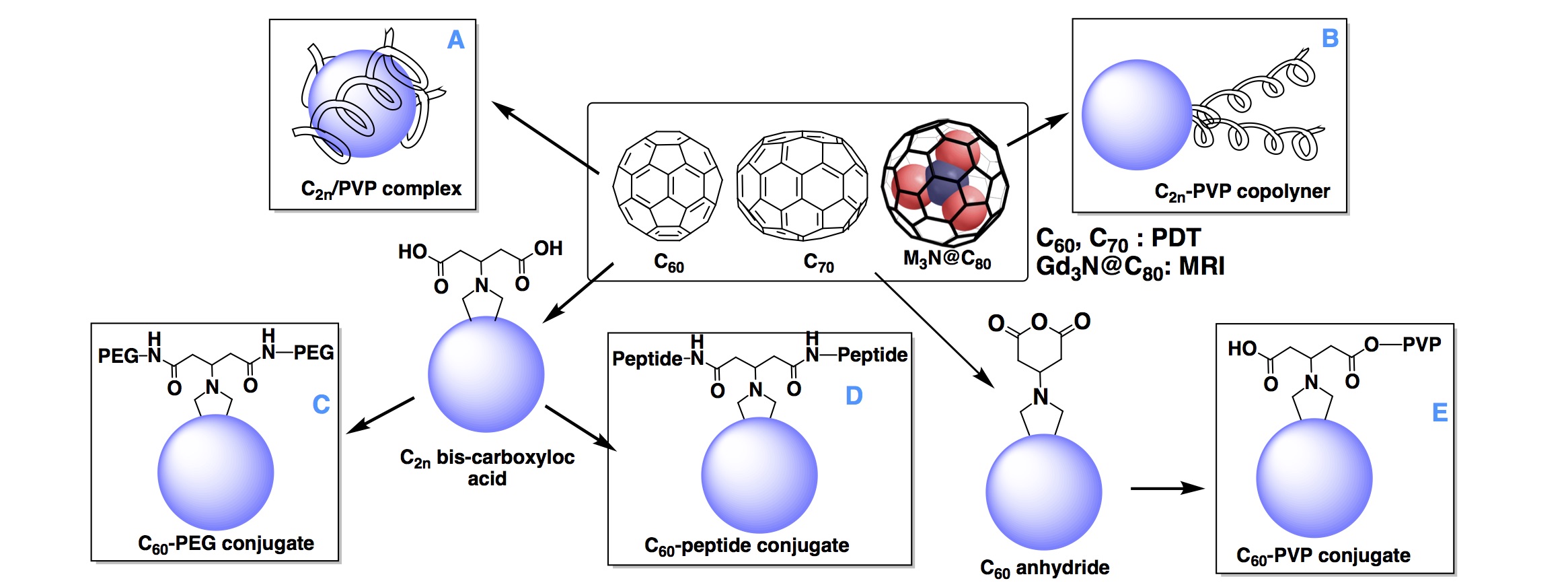Photosensitive Materials
–Fullerenes and porphyrins as photosensitive biomaterials–
1. Conditionally activatable C60 photosensitizer
C60-fluorophore conjugates connected with MMP-cleavable peptide linker were synthesized and tested by in vitro enzymatic tests. Upon addition of MMP2/9, fluorescence intensity was raised by the cleavage of peptide linkers to detect the MMP-expressing cell lines. Simultaneously, increased single oxygen generation was observed in the presence of MMP2/9 under visible light irradiation to selectively damage the MMP-expressing cells, often related to the malignancy of the diseases. This conditionally activated photosensitivity and fluorescence can be potentially used for the simultaneous diagnosis and therapy of the malignant cancers and atherosclerosis, where MMP2/9 are often overexpressed.
Funding Souces: SNF, ETH Grants
Collaborators: Prof. Dr. Martin Baumgartner (University of Zurich, Childrens Hospital), Dr. Sung-Sik Lee (ETH ScopeM)
Publications: Small 2025.
2. Reactive oxygen species generation by fullerenes and photodynamic therapy (PDT) application
In addition to the singlet oxygen (1O2), we discovered the generation of superoxide radical anion (O2•–) from the photoexcited C60 and C70. The DNA cleavage and antibacterial activity was related to this ROS generation. Currently, we are investigating the specific conditions that generate 1O2 and O2•– through, respectively, energy and electron transfer reactions, for the suitable design of photodynamic therapeutic compounds.
Funding souces: SNF, ETH Grants, Ministry of Education-Japan, HS Foundation-Japan
Collaborators: Prof. Dr. Tetsuo Nagano (the University of Tokyo), Prof. Dr. Naoki Umezawa (Nagoya City University), Dr. Toshiki Masumizu (JEOL Co. Ltd), Prof. Dr. Barbara Ventura (University of Bologna), Prof. Dr. Nicola Armaroli (University of Bologna)
Publications: ACS Phys. Chem. Au 2025, Chem. Sci. 2025, J. Synth. Org. Chem. 2024, JACS Au, 2021, Helv. Chim. Acta 2016, Org. Lett. 2016, Faraday Discuss. 2014, J. Am. Chem. Soc. 2003, J. Am. Chem. Soc. 1998, J. Org. Chem. 1996.
3. Water-soluble fullerene materials
To tackle the extreme insolubility of fullerenes (C60, C70 etc.), which also causing the problem in the usage of them as biomaterials, water-soluble materials were prepared in combination with biocompatible non-toxic polymers, poly(vinylpyrrolidone) (PVP) and PEG. Non-covalent and covalent functionalizations were used to produce both non-defined and well-defined molecular weights and structure. Current studies include addition of targeting moieties to the diseases in vivo and as a photosensitizer in photodynamic therapies.
Funding Sources: SNF, ETH Grants, Ministry of Education-Japan, Ministry of Health and Welfare-Japan, University of Pennsylvania CEET (NIH)
Publications: Beilstein J. Org. Chem. 2024, JACS Au, 2021, Org. Lett. 2019, Helv. Chim. Acta, 2016, Polymer Chem. 2015, Org. Lett. 2013, Chem. Commun. 2013, Chem. Commun. 2006, J. Chem. Soc., Chem. Commun. 1994.

